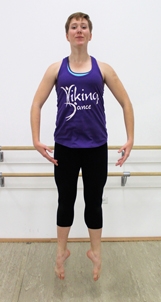Understanding turnout
A common term teachers use in dance classes (especially ballet), is the word turnout. Turnout is achieved by outward (lateral/external) rotation of the leg. It originates from the hip socket while engaging the deep six lateral rotator muscles. Using proper turnout is a technical staple in many genres of dance, but the concept of turnout is rooted deep in the history of ballet.
Why do we use turnout?
Ballet was born out of the Italian Renaissance and was introduced to France by Catherine de Medici in the mid 1500’s who infused early concepts of ballet into the opulence of court life. Later in the 17th century, King Louis XIV established the first dance school, Académie Royale de Danse. Under its director, Pierre Beauchamp, the five basic positions of the feet were solidified and ballet became a codified language.

Turnout was initially used by King Louis XIV himself to display his opulent shoes and also in court fencing duels and demonstrations which then influenced the aesthetic of ballet. The degree of turnout has evolved over the centuries, and today we use turnout not only as a preservation of the history and custom of ballet tradition, but also to facilitate greater range and ease of motion with sideways movements. Turning out also showcases a longer leg line by displaying a sideways view of the arch of the foot when pointed and make the elongation through the back of knee more visible.
The truth about turnout
In ballet today, the “ideal” rotation in turnout is 180 degrees. Since this maximum turnout is unnatural for the body, dancers must train, develop and strengthen the turnout muscles over the course of time to be able to achieve this position. However, this is not mandatory to be able to dance ballet with proper technique. Certain anatomical and physiological factors can actually make it difficult or impossible to achieve this maximum level of turnout. Remember that it is more important to correctly use and work your turnout than to improperly force your body into a greater turnout. Forcing your turnout or improperly using your turnout can lead to injury. The good news is that it is possible to improve your turnout with mindful training!
Watch out for:
- Rolling inward on the feet or gripping the toes
- Pain/strain in the knee joints
- Knees tracking inward/forward instead of outward over the second toes
- Leaning forward with the chest
- Sway back/Hyper extending the lumbar spine (lower back)
These may indicate you need to strengthen your turnout muscles to maintain the rotation, you may be forcing your turnout, or that you may not be activating the turnout muscles enough. When using your turnout, you want to make sure it is functional. Turnout should be able to be maintained with proper balance, alignment, support and without pain. Forcing a maximum turnout is unsafe and can lead to injury. If you want to strengthen your turnout muscles and increase your rotation, start a daily routine of exercises and stretches geared specifically towards those muscles. Be careful not to overdo it!
 Exercises to help turnout
Exercises to help turnout
Floor exercises
- Clam shells
- Lisa Howell’s exercise for standing leg turnout
Standing
- Parallel eleves into a turned out first position
- Lifting the leg into turned out Passe slowly (with or without resistance bands)
Helpful stretches
- Figure 4 stretch seated or standing with support
- Lunges
TIP: Core strengthening exercises will help your overall alignment when using your turnout.

 What does physics have to do with dance or jumps?
What does physics have to do with dance or jumps? Pay attention to your plié
Pay attention to your plié